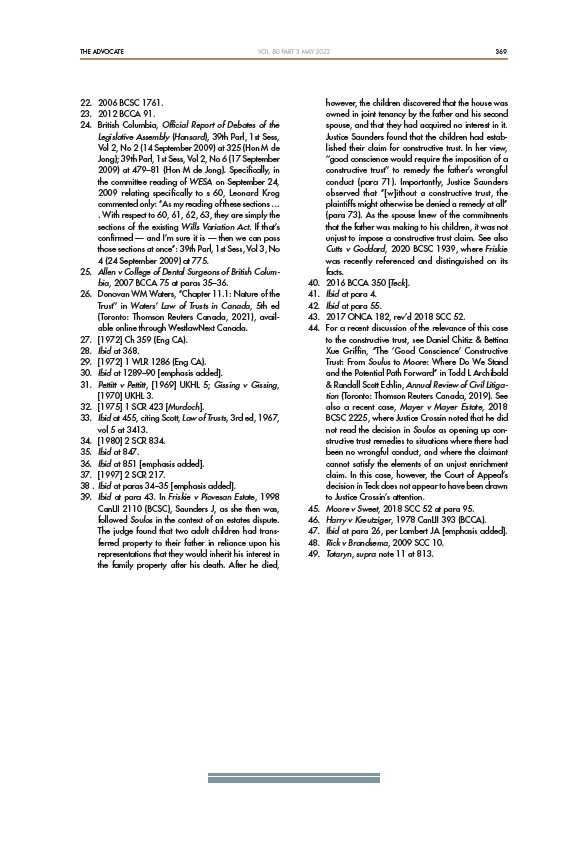
THE ADVOCATE 369
VOL. 80 PART 3 MAY 2022
22. 2006 BCSC 1761.
23. 2012 BCCA 91.
24. British Columbia, Official Report of Debates of the
Legislative Assembly (Hansard), 39th Parl, 1st Sess,
Vol 2, No 2 (14 September 2009) at 325 (Hon M de
Jong); 39th Parl, 1st Sess, Vol 2, No 6 (17 September
2009) at 479–81 (Hon M de Jong). Specifically, in
the committee reading of WESA on September 24,
2009 relating specifically to s 60, Leonard Krog
commented only: “As my reading of these sections …
. With respect to 60, 61, 62, 63, they are simply the
sections of the existing Wills Variation Act. If that’s
confirmed — and I’m sure it is — then we can pass
those sections at once”: 39th Parl, 1st Sess, Vol 3, No
4 (24 September 2009) at 775.
25. Allen v College of Dental Surgeons of British Columbia
, 2007 BCCA 75 at paras 35–36.
26. Donovan WM Waters, “Chapter 11.1: Nature of the
Trust” in Waters’ Law of Trusts in Canada, 5th ed
(Toronto: Thomson Reuters Canada, 2021), available
online through WestlawNext Canada.
27. 1972 Ch 359 (Eng CA).
28. Ibid at 368.
29. 1972 1 WLR 1286 (Eng CA).
30. Ibid at 1289–90 emphasis added.
31. Pettitt v Pettitt, 1969 UKHL 5; Gissing v Gissing,
1970 UKHL 3.
32. 1975 1 SCR 423 Murdoch.
33. Ibid at 455, citing Scott, Law of Trusts, 3rd ed, 1967,
vol 5 at 3413.
34. 1980 2 SCR 834.
35. Ibid at 847.
36. Ibid at 851 emphasis added.
37. 1997 2 SCR 217.
38 . Ibid at paras 34–35 emphasis added.
39. Ibid at para 43. In Friskie v Piovesan Estate, 1998
CanLII 2110 (BCSC), Saunders J, as she then was,
followed Soulos in the context of an estates dispute.
The judge found that two adult children had transferred
property to their father in reliance upon his
representations that they would inherit his interest in
the family property after his death. After he died,
however, the children discovered that the house was
owned in joint tenancy by the father and his second
spouse, and that they had acquired no interest in it.
Justice Saunders found that the children had established
their claim for constructive trust. In her view,
“good conscience would require the imposition of a
constructive trust” to remedy the father’s wrongful
conduct (para 71). Importantly, Justice Saunders
observed that “without a constructive trust, the
plaintiffs might otherwise be denied a remedy at all”
(para 73). As the spouse knew of the commitments
that the father was making to his children, it was not
unjust to impose a constructive trust claim. See also
Cutts v Goddard, 2020 BCSC 1939, where Friskie
was recently referenced and distinguished on its
facts.
40. 2016 BCCA 350 Teck.
41. Ibid at para 4.
42. Ibid at para 55.
43. 2017 ONCA 182, rev’d 2018 SCC 52.
44. For a recent discussion of the relevance of this case
to the constructive trust, see Daniel Chitiz & Bettina
Xue Griffin, “The ‘Good Conscience’ Constructive
Trust: From Soulus to Moore: Where Do We Stand
and the Potential Path Forward” in Todd L Archibald
& Randall Scott Echlin, Annual Review of Civil Litigation
(Toronto: Thomson Reuters Canada, 2019). See
also a recent case, Mayer v Mayer Estate, 2018
BCSC 2225, where Justice Crossin noted that he did
not read the decision in Soulos as opening up constructive
trust remedies to situations where there had
been no wrongful conduct, and where the claimant
cannot satisfy the elements of an unjust enrichment
claim. In this case, however, the Court of Appeal’s
decision in Teck does not appear to have been drawn
to Justice Crossin’s attention.
45. Moore v Sweet, 2018 SCC 52 at para 95.
46. Harry v Kreutziger, 1978 CanLII 393 (BCCA).
47. Ibid at para 26, per Lambert JA emphasis added.
48. Rick v Brandsema, 2009 SCC 10.
49. Tataryn, supra note 11 at 813.